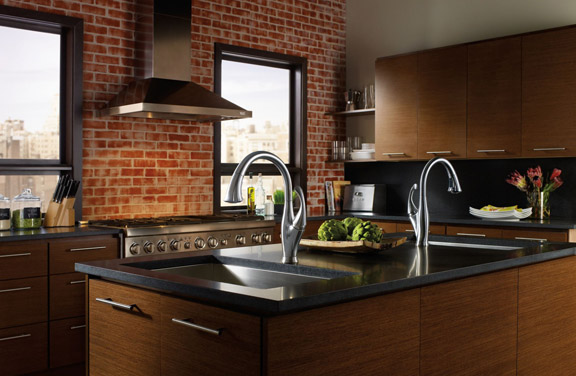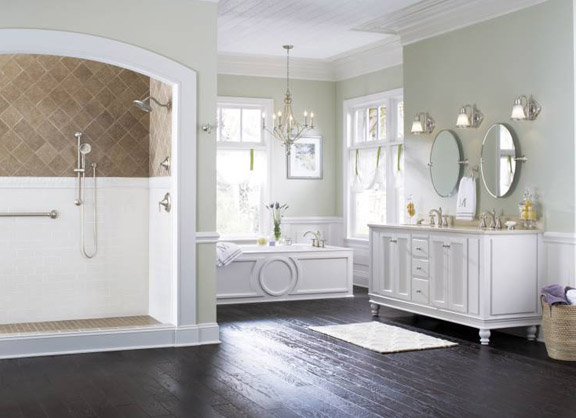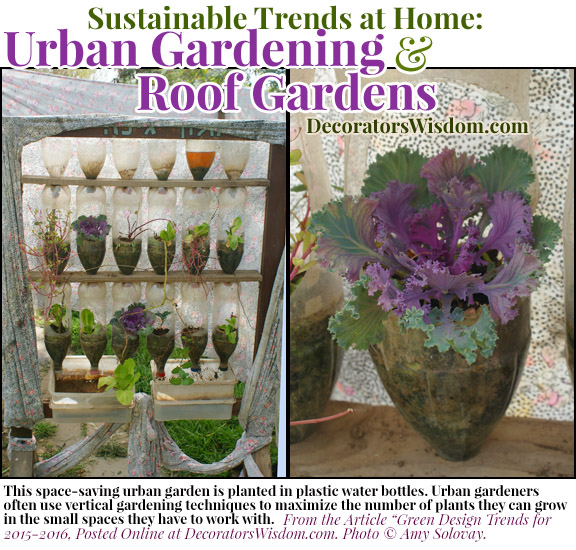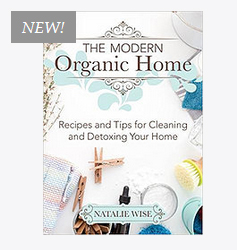In 2024, green design is one of the most important carryover trends we’ll be seeing in the home interiors marketplace. Let’s take a look at some of the most prominent green design trends we’ll see happening in 2024.
Water Efficient Home Appliances, Kitchen Fixtures and Bathroom Fixtures
Water conservation is shaping up to be an important issue for 2024. For many regions of the United States, 2023 was wetter and rainier than usual. However, that hasn’t totally eased the water scarcity issues in some areas of the country. As of February 13, 2024, experts at the the U.S. Drought Monitor reported that
“16.32% of the U.S. and Puerto Rico and 19.46% of the lower 48 states are in drought.”
The Colorado River feeds Lake Powell and Lake Mead and is the go-to water source that about 40 million people rely on. According to Reclamation Commissioner Camille Calimlim Touton,
“…Lake Powell and Lake Mead – the two largest reservoirs in the United States and the two largest storage units in the Colorado River system – remain at historically low levels.”
While water conservation is an ongoing theme, and certainly not a new trend, it’s an important inclusion on this list.
In the recent past, water conservation efforts have been a driving factor in the marketplace. The need for water efficiency is contributing to the product lines that manufacturers make available — which in turn influences building, remodeling and decorating projects nationwide.
Broader trends are also at play here. Mainstream media has been sounding the alarm over what some analysts perceive to be a looming worldwide overpopulation problem, which they predict will result in inadequate worldwide water resources. This barrage of information has influenced consumer perception, and is contributing to increased interest in water efficient solutions at home, particularly in California and the American southwest. Many southwesterners are in search of ways to lower their overall water consumption — and also to lower the corresponding water bills they have to pay.
Water is an issue that regulatory agencies are paying attention to. In particular, the US EPA (Environmental Protection Agency) is encouraging water conservation efforts in American households. Their efforts are not only establishing goals for manufacturers to strive for, but also setting trends at the same time. They’re accomplishing this in part by pioneering an EPA sponsored and federally funded program known as “Watersense.”
Watersense participants are rewarded with a special seal that designates water efficient homes, products, fixtures and appliances that meet the stringent Watersense standards and criteria.

The EPA’s WaterSense website is strangely silent on the topic of kitchen faucets, but that hasn’t discouraged certain manufacturers from designing water-efficient faucets to sell to the public. For example, Delta Faucet is a certified WaterSense partner offering a range of water-saving fixtures, including kitchen fixtures. Delta has come up with a kitchen faucet they call “Addison” that’s water-efficient by default, but a user can toggle it into high-powered mode for tasks that require increased water pressure. This could help consumers to maximize efficiency, while minimizing water consumption and the resulting water bills.

Water-Saving Showerheads

Most people don’t think too much about showerheads — but maybe it’s time we stop to consider them for a moment. Did you know that choosing a different showerhead could not only lower your water consumption, but also your power bill as well? At least, that’s true if you shower with hot water, because your hot water heater is also involved in the showering process — and your hot water heater consumes energy when heating the water you shower with.
The EPA has clarified how much of a savings the average family could expect, just by switching showerheads:
“The average family could save 2,900 gallons per year by installing WaterSense labeled showerheads. Since these water savings will reduce demands on water heaters, they will also save energy. In fact, the average family could save more than 370 kilowatt hours of electricity annually, enough to power a house for 13 days.”
Not only that, the stylish and trendy showerheads available can also help to update the look of your bathroom as well.
Water Efficient Bathroom Faucets
There are bunches of easy ways to conserve water at home. One of the simplest is to install water-saving fixtures in the bathroom(s) and kitchen. This simple action can also result in significant savings on future water bills.
According to the experts at the US Environmental Protection Agency’s WaterSense website,
“Replacing old, inefficient faucets and aerators with WaterSense labeled models can save the average family 700 gallons of water per year, equal to the amount of water needed to take 45 showers. Also, since these water savings reduce demands on water heaters, households will also save enough energy to run a hairdryer 17 minutes a day for a year. Achieving these savings can be as easy as twisting on a WaterSense labeled aerator, which can cost as little as a few dollars.
“If every home in the United States replaced existing faucets and aerators with WaterSense labeled models, we could save nearly $1.3 billion in water and energy costs and 69 billion gallons of water across the country annually—equivalent to the annual household water needs of more than 680,000 American homes.”
Water Saving Toilets — I’m not sure if anyone cares much about toilets when they’re researching interior design trends. Nevertheless, it’s worth including a note about toilets on this list, because toilets do contribute significantly to household water consumption. That alone makes the toilet an important consideration for anyone remodeling a bathroom or building a new home.
According to the EPA, toilets can account for as much as 30% of the total water consumption in many households. If you’re looking to lower your water bills, offset costs associated with remodeling, or make tangible investments in your home, a water efficient toilet is worthwhile purchase to consider.
If you’re an industry professional handling remodeling or decorating jobs for others, it could be worthwhile to educate your customers about the long-term cost savings and other benefits provided by water efficient toilets.
Water Efficient Kitchen Faucets

The EPA’s WaterSense website is strangely silent on the topic of kitchen faucets, but that hasn’t discouraged certain manufacturers from designing water-efficient faucets to sell to the public. For example, Delta Faucet is a certified WaterSense partner offering a range of water-saving fixtures, including kitchen fixtures. Delta has come up with a kitchen faucet they call “Addison” that’s water-efficient by default, but a user can toggle it into high-powered mode for tasks that require increased water pressure. This could help consumers to maximize efficiency, while minimizing water consumption and the resulting water bills. Considering these savings, it seems it would definitely be worth seeking out water-efficient faucets next time you remodel your kitchen, bathroom, or laundry room.
Water Filtration Faucets and Other Water Filters — Right now, there’s strong demand for water filtration units and devices. For some industry professionals, there could be potential to upsell these sorts of devices along with kitchen faucets and fixtures, as part of a kitchen redesign or remodeling project.
Energy-Conserving Insulation
There’s a trend towards energy efficiency in every aspect of home ownership, and there has been significant demand for extra insulation in new residential construction.
LED Lighting
According to experts at the US Department of Energy (US DOE),
“LED is a highly energy-efficient lighting technology, and has the potential to fundamentally change the future of lighting in the United States. Residential LEDs — especially ENERGY STAR rated products — use at least 75% less energy, and last up to 25 times longer, than incandescent lighting.
“Widespread use of LED lighting has a large potential impact on energy savings in the United States. By 2035, the majority of lighting installations are anticipated to use LED technology, and energy savings from LED lighting could top 569 TWh annually by 2035, equal to the annual energy output of more than 92 1,000 MW power plants.”
So, by all appearances, this is a trend that will have long-term staying power.
In the long term, LED lighting offers consumers an opportunity to increase energy efficiency and reduce their energy bills. The downside is that the upfront installation costs can be higher for LED lighting. However, overall the clear consensus is that the long-term energy cost and energy savings more than justify the upfront expense.

Urban Gardening, Window Gardens and Roof Gardens
Several broader lifestyle trends are converging to fuel the popularity of urban gardening:
- Food prices are rising.
- The demand for local food is increasing. There are pockets scattered throughout the USA where demand for locally-grown food far outpaces supply.
- Demand for organic food is also increasing. While organics still comprise about 6% of the food market overall, the growth we’re seeing in this sector far outpaces the growth of the US economy as a whole. The demand for organics is trending upward, despite inflationary pressures and a challenging economic market.
- Many consumers who want to consume locally grown or organic foods are deterred by the high costs, and looking for less expensive solutions.
The result: increasing numbers of urbanites and suburbanites are transforming portions of their patios, balconies, kitchens, homes, roofs, and backyards into micro-gardens. Roof gardens are particularly trendy at the moment. Window boxes and kitchen herb gardens are also gaining in popularity.
Organic Textiles and Sustainable Building Materials
Consumers are increasingly shopping for low-impact materials to use when remodeling, building and decorating their homes. They are also becoming more conscious of the toxic nature of many building and decorating materials that have been popular in decades past — and looking to reduce the overall toxicity levels that their families are subjected to daily. Thanks to this increased consciousness, there’s growing demand for organic textiles, natural fabrications and sustainable building materials.
Organic Cotton — Overall, sales of organic products have been growing steadily ever since I have been writing these trend reports (starting in 2013, more than a decade ago). Sales of organic food products make up the bulk of this growth, but organic textiles are an important sector of the market that should not be overlooked. According to a past Organic Trade Association press release,
Non-food organic products—including flowers, fiber, household products and pet food—are currently a very small part of the total organic market, but are making quick in-roads.
According to the OTA’s latest 2023 Organic Industry Survey,
“Organic food sales in the United States in 2022 broke through $60 billion for the first time, hitting another high-level mark for the resilient organic sector. Total organic sales – including organic non-food products, were a record $67.6 billion”.
Doing the math on that, we can infer that consumers spent around 7.6 billion on non-food products such as organic textiles and organic pet products.
According to Organic Trade Association data, in 2022,
…”sales of organic linens and clothing accounted for … $2.4 billion in sales for a gain of 2.5 percent.”
Conventionally farmed cotton is sprayed with high concentrations of synthetic pesticides and other harmful chemical inputs. Because of this, conventional cotton crops are responsible for significant amounts of environmental harm.
Cotton is also one of the most important genetically modified crops, which many environmentalists — myself included — see as being harmful to the ecosystem, to wildlife, and to human health.
Who’s Buying Organic Cotton Products? The demographic group most likely to buy home furnishings made with organic cotton: new parents. Demand is particularly strong for organic baby bedding, organic baby blankets and organic nursery accessories. In 2017, the Organic Trade Association reported,
“Millennial parents – parents in the 18- to 35-year-old age range — are now the biggest group of organic buyers in America.”
More recent data from consulting firm, McKinsey, corroborates the assertion that millennials are currently the generation spending most on organics, although their data is primarily focused on reporting on millennials’ consumption of organic food products.
Organic cotton is also a popular choice for kitchen textiles, particularly dishcloths, dish towels, placemats, table linens and anything else that will be used in close proximity to food.
In the bedroom, organic bedding is becoming more widely available.
Sustainable Flooring Trends for 2024
Earth-Friendly Tile — There are a broad range of possible applications for tile, both inside and outside the home. Whether you use tile for flooring or other purposes, you’ll enjoy having a range of on-trend and earth-friendly options available.
Reclaimed tiles are particularly relevant to the discussion here. While this segment is still a small portion of the overall market, we saw a surge of increased interest in reclaimed tile as of March 2015. Interest has been particularly strong in the UK, although there’s interest from the USA as well. Stone tile is also in demand, with the majority of the interest coming from the USA and Canada. In general, tile sales in the USA were trending up as of early 2018.
Hardwood Flooring — It would be a little silly for me to write that hardwood flooring is trendy at the moment. Does hardwood flooring ever really go out of style? No, I think not.
Of course, current economic realities being what they are, there’s also strong demand for the less expensive laminate flooring as well.
Reclaimed wood flooring is a particularly eco-friendly solution that’s on-trend at the moment. In the UK, USA and Canada there’s a steadily growing interest in, and demand for reclaimed wood flooring materials. Reclaimed flooring has its challenges, but for those who are able to overcome them, it’s easy to see the appeal of this category; reclaimed flooring is not only sustainable, it also offers the homeowner unique character and charm. In theory, it should also be affordable — and in some cases, it is. However, in some areas, demand has outpaced supply, so the prices for reclaimed wood flooring are are higher than you might expect.
Net Zero Buildings
An organization known as the International Living Future Institute offers a certification for “Net Zero Buildings”. What this means: the power consumption in these buildings is net zero. In other words, the building’s infrastructure and systems generate at least as much power as its occupants consume. While this is challenging to achieve, it’s a worthy goal to pursue. We’re hoping to see this concept catch on and gain steam in the future.
Getting in on This Trend: How to Create Your Own Sustainable Home

If you haven’t yet started working at creating your own green, sustainable home, it’s never too late to get started. The best way to begin: Go green in baby steps. There is no need to replace every surface in your home. The most sustainable approach is to only replace things that truly need replacing and continue using things that don’t need replacing, even if they appear a bit outdated. Start with little things like the food in you refrigerator and the cleaning products in your cabinets. When your sheets or other linens inevitably wear out, replace them with organic ones.
If you need help figuring out how to approach the overwhelming task of creating an environmentally friendly home, The Modern Organic Home by Natalie Wise is an excellent starting place. It’s a book I highly recommend.
References
- At the Farnsworth Group Website: Homeowner Trends Regarding Healthy Homes, Air Quality, and Green Remodeling Projects
- At the US Department of Energy Website: LED Lighting and Life-Cycle Assessment of Energy and Environmental Impacts of LED Lighting Products (That PDF is no longer available online –sorry).
- Also at the US Department of Energy Website: Top 8 Things You Didn’t Know About LEDs (This article is no longer available online)
- At the Environmental Protection Agency Website: Watersense toilets; bathroom sink faucets; showerheads; and bathroom faucets
- At the US Drought Monitor Website: National Drought Status
- At the US Bureau of Reclamation Website: Reclamation announces 2024 operating conditions for Lake Powell and Lake Mead
- At the the International Living Future Institute Website: Net Zero
- At the Organic Trade Association Website: Consumer Attitudes and Beliefs Study
- At the Organic Trade Association Website: 2023 Organic Industry Survey
- At the Organic Trade Association Website: American appetite for organic products breaks through $35 billion mark
- At the Organic Consumers Website: Organic Produce Sales Show No Signs of Slowing
- At the Rodale Institute Website: Chemical Cotton
- At the Organic Trade Association Website: Get the facts about Organic Cotton
- At the McKinsey Website: Millennials Go Organic
- At the Pesticide Action Network Website: Cotton
- At the Organic Cotton Website: Pest Management
- At the Delta Faucet Website: The Addison Kitchen Faucet
- At the Colorado Sun Website: 2024 forecasts show less water will flow into Lake Powell. Don’t panic, experts say.
- At the Utah Public Radio Website: Here’s how water moves through Lake Powell
Learn More About the Hottest Interior Design Trends for 2024
- 2024 Kitchen Design Trends: Countertops, Appliances, Backsplashes, Hardware, Flooring, Colors and More
- Interior Color Trends for 2024
- 2024 Kitchen Design Trends
- 2024 Bathroom Remodeling Trends
- 2024 Lighting Trends
- Color Trends 2024
- 2024 Flooring Trends
- 2024 Entry Door Trends
- Interior Design Trends for 2024
Posted By: Amy Solovay
This page was last updated on 2-20-2024